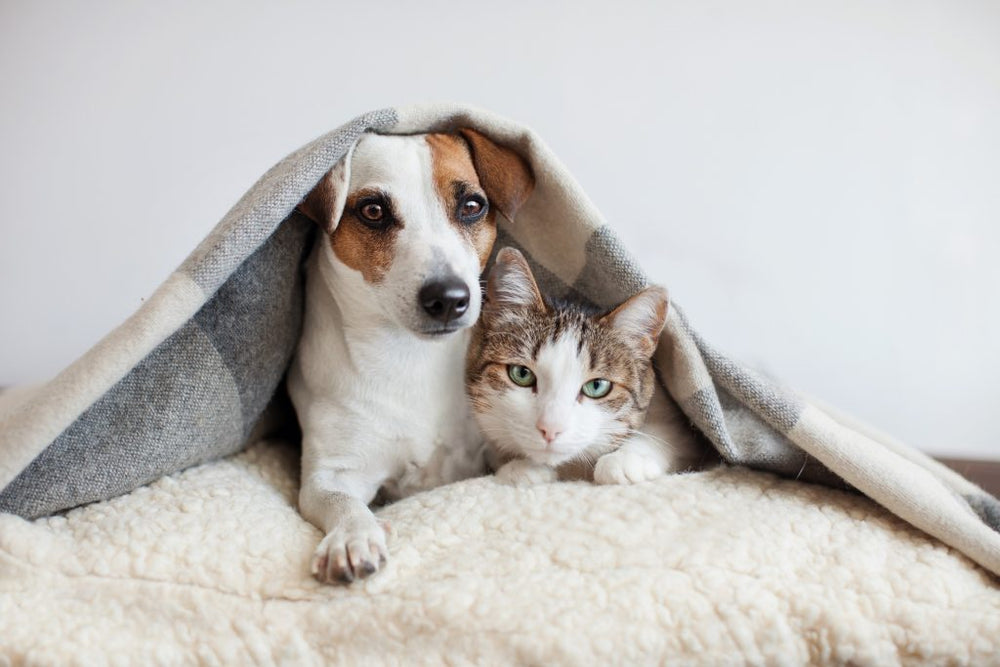Keeping Pets Warm in Winter
As winter approaches and the evenings begin to cool, we all reach for our fluffy slippers and thick dressing gowns and the extra doona gets pulled from the back of the closet. But, what about our four legged friends, especially those that spend their time outside or sleep in the laundry.
There are many reasons why we should be paying attention to how our cats and dogs are coping with the changes in seasons, not least the impact that this can have on their health. At every age, cold weather and dampness can make a cat or dog more prone to illness, more affected by joint pain and unsettled from not being able to relax into a cozy corner. Even with their fur coats, dogs and cats feel the cold and this is especially true for those with short hair.
KEEPING PUPPIES AND KITTENS WARM
When puppies and kittens are still very young, they snuggle with their siblings into their mother’s body for warmth and comfort. Therefore, when we first bring them home, they love nothing better than to curl up on your lap or in your arms. The warmth from your body mimics that of their mum.
Of course, the reality is that we can’t always be home for our kittens and puppies and it’s not really good practice to encourage them to sleep on your bed at night. And, because they are not house trained yet, they are often relegated to the cold laundry or a pet cage. This time of independence is important for their development into adulthood but can be stressful for them initially if the area is not prepared well.
To calm kittens and puppies and to make them feel more comfortable, it is important for them to be given a warm, cozy bed that they can snuggle into just like they did with their mum. Prepare a bed, preferably one that can be washed just in case they soil it, and line it with a thick, warm blanket. Add in their favorite toys including a stuffed one that they have played with during the day as well as one of your own unwashed t-shirts so that it can smell that you are still around. Finally, to really ensure that the little one feels warm and safe, place a snuggle safe pad under the blanket as this will stay warm for up to 10 hours and mimic its mother’s body.
Snuggle safe pads are microwavable disks which are scratch and tear resistant and can be easily wiped clean. They are heated in the microwave for just a few minutes and are then placed under the bedding which the pet sleeps on. They will stay warm all night and, unlike electric heating pads, are quite safe for puppies and kittens.
EASING JOINT PAIN
As dogs and cats age, they sometimes develop joint pain and arthritis which becomes more painful for them in cooler weather. Arthritis and joint pain is often difficult to identify in animals as it develops very slowly and they tend not to complain or show symptoms until it is quite bad.
Limping and difficulty in getting off a bed or up and down stairs is an obvious indicator of arthritis as is a reduced willingness to move and obvious pain after exercise. All of this is exacerbated when the animal has spent a long period of time lying in the same position on a cold floor, a hard surface or in a chilly kennel.
After a visit to the veterinarian for a check up and treatment, the next thing to do is to find ways to ease the animal’s pain and to make it feel more comfortable by providing a warm environment and bedding.
Many cats will find small areas to curl up in whether it is in a sunny window, on the sofa or in their bed but for a bit of extra warmth, consider getting them a cat igloo or box which holds the warmth in from their own body. They will think this is heaven if you also add a snuggle pad into this each night before they go to bed. Small dogs may also enjoy an igloo-style bed with a heated snuggle pad but will also appreciate an extra blanket in the bed as well.
Whether small or large, look at where the pet’s bed is placed. For extra comfort, ensure that the bed is raised off the ground as this will prevent the cold concrete, timber or tiles from making the bottom of the bed cold as well. For dogs, trampoline-type beds are ideal if they are covered with warm padding to ease the joints. These are also easier for a dog to get on and off with little exertion because they are at the height of their knees and less bending is required. Make sure the bed is moved away from drafts and windows; glass is not a good insulator in winter and will make the animal even colder.
Outdoor kennels should also be raised off the ground even if just with bricks underneath and ensure that the timber is not damp and that the roof and walls are waterproof. Add in plenty of blankets and hang them out every few days to allow them to air so that they don’t stay damp as well. Microwavable disks or snuggle pads are safe to use overnight in outdoors kennels as well and will last for up to 10 hours to give the dog great comfort.
A warm jacket is a must for outdoor dogs in winter and also for short haired ones such as greyhounds and dalmatians, even if they do spend time inside. Jackets that cover the belly are best at keeping a dog warm as they trap the heat in from their own body. Keep a second water-repellent jacket for walking the dog to ensure that it stays dry but if it does get wet, dry it thoroughly to make sure that it doesn’t stay cold for many hours.
FEEDING FOR WINTER
Outdoor dogs and cats actually burn off more calories in winter than they do in summer because they are trying to keep themselves warm so expect that they are going to be a little hungrier. Instead of giving more treats, increase the amount of food that they get in their evening meals allowing you to monitor how much they are eating more easily so that they don’t put on weight.
GROOMING FOR WINTER
It’s important to maintain a good grooming regime through winter, especially in cats and dogs with long fur. Avoid shaving or cutting their hair if possible as the longer fur keeps them warm during winter but they do need to be brushed more often to prevent it becoming matted and this will also help alleviate dander between washes. Furminators are particularly good in winter as they strip out the dead hair whilst still leaving it long for that extra warmth.
Dogs don’t actually need to be bathed as often as we might think during winter but if they do need a wash make sure the water is warm and dry them off completely so that they don’t get a chill. Most Better Pets and Gardens stores have a DIY dog wash which allows you to wash your dog with warm water and then dry them with the built in dryer. The dog will feel like it’s been at a salon.




